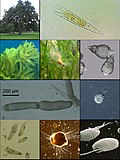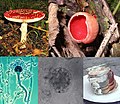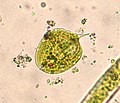Euglenozoa are a large group of flagellate Discoba. They include a variety of common free-living species, as well as a few important parasites, some of...
26 KB (1,770 words) - 17:22, 23 October 2024
Except for some Euglenozoa, all are non-photosynthetic. Most excavates are unicellular, heterotrophic flagellates. Only some Euglenozoa are photosynthetic...
20 KB (1,637 words) - 15:47, 3 September 2024
Kleptoplasty (section Euglenozoa)
eukaryotes, namely single-celled protists of the SAR supergroup and the Euglenozoa phylum, and some marine invertebrate animals. Some species of the foraminiferan...
16 KB (1,589 words) - 08:07, 14 June 2024
Protozoan infection (section Euglenozoa)
Trichomonas vaginalis can be treated with a course of antibiotics. Most Euglenozoa are photoautotrophic, but some are chemoorganotrophs (saprophytic). They...
32 KB (3,716 words) - 02:51, 17 September 2024
Discicristata is a proposed eukaryotic clade. It consists of Euglenozoa plus Percolozoa. It was proposed that Discicristata plus Cercozoa yielded Cabozoa...
2 KB (174 words) - 20:21, 20 November 2023
Euglenid (category Euglenozoa)
group contains the carbohydrate paramylon. Euglenids split from other Euglenozoa (a larger group of flagellates) more than a billion years ago. The plastids...
18 KB (2,069 words) - 05:35, 20 August 2024
(including plants) Provora Hemimastigophora Jakobea Tsukubea Discicristata Euglenozoa Percolozoa Scotokaryotes Podiata (including fungi and animals) Metamonada...
61 KB (6,102 words) - 11:22, 19 October 2024
Largest organisms (section Euglenozoans (Euglenozoa))
This article lists the largest organisms for various types of life and mostly considers extant species, which found on Earth can be determined according...
22 KB (3,091 words) - 22:17, 17 August 2024
Euglenaceae (category Euglenozoa)
Euglenaceae (also known as Euglenidae) is a family of flagellates in the phylum Euglenozoa. The family includes the most well-known euglenoid genus, Euglena. The...
6 KB (463 words) - 16:07, 29 April 2024
Jakobida Tsukubamonas Discicristata Heterolobosea Euglenozoa...
128 KB (11,452 words) - 07:21, 26 October 2024
Euglenophyceae (category Euglenozoa)
Euglenea (ICZN) is a group of single-celled algae belonging to the phylum Euglenozoa. They have chloroplasts originated from an event of secondary endosymbiosis...
5 KB (676 words) - 02:21, 20 May 2024
as a class) is a group of flagellated protists belonging to the phylum Euglenozoa, and characterised by the presence of a distinctive organelle called the...
14 KB (1,306 words) - 02:28, 23 October 2024
Protists in the fossil record (section Euglenozoa)
A protist is any eukaryotic organism (that is, an organism whose cells contain a cell nucleus) that is not an animal, plant, or fungus. While it is likely...
70 KB (7,729 words) - 07:09, 4 January 2024
Euglena viridis (category Euglenozoa species)
other well-known Euglena species: Euglena gracilis. The whole group of Euglenozoa was originally placed in a group called Excavata. However, Excavata has...
7 KB (735 words) - 16:54, 18 September 2024
Trypanosoma (category Euglenozoa genera)
unicellular parasitic flagellate protozoa. Trypanosoma is part of the phylum Euglenozoa. The name is derived from the Greek trypano- (borer) and soma (body) because...
19 KB (2,089 words) - 12:26, 16 May 2024
Rapaza (category Euglenozoa)
photosynthesis and ingestion of food) and kleptoplastic species within the phylum Euglenozoa. It eats microalgae by engulfing them—a process called phagocytosis—and...
16 KB (2,305 words) - 02:26, 20 May 2024
includes most of the species engaging in photosynthesis, except for the Euglenozoa and Cyanobacteria. It includes all Bikonts that are not excavates. The...
8 KB (739 words) - 03:55, 2 October 2024
Discicristata clade, which unites well-known phyla Heterolobosea and Euglenozoa. Heterolobosea includes amoebae, flagellates and amoeboflagellates with...
95 KB (9,835 words) - 08:24, 4 October 2024
Jakobida Tsukubamonas Discicristata Heterolobosea Euglenozoa...
95 KB (8,058 words) - 07:51, 19 October 2024
Jakobida Tsukubamonas Discicristata Heterolobosea Euglenozoa...
200 KB (19,205 words) - 04:22, 24 October 2024
Euglena (category Euglenozoa genera)
functioning chloroplasts. In 1997, a morphological and molecular study of the Euglenozoa put Euglena gracilis in close kinship with the species Khawkinea quartana...
28 KB (3,064 words) - 00:09, 4 August 2024
Cavalier-Smith, Thomas (2016). "Higher classification and phylogeny of Euglenozoa". European Journal of Protistology. 56: 250–276. doi:10.1016/J.EJOP.2016...
205 KB (15,566 words) - 19:15, 6 October 2024
Spirocuta (category Euglenozoa taxa)
euglenids, single-celled eukaryotes or protists belonging to the phylum Euglenozoa. They are distinguished from other euglenids by active deformation of...
5 KB (621 words) - 16:49, 28 April 2024
Euglenales (category Euglenozoa)
Euglenales (also known as Euglenida) is an order of flagellates in the phylum Euglenozoa. The family includes the most well-known euglenoid genus, Euglena, as...
4 KB (395 words) - 16:07, 29 April 2024
Jakobida Tsukubamonas Discicristata Heterolobosea Euglenozoa...
36 KB (2,538 words) - 09:28, 31 October 2024
GFAP astrocytopathy. Naegleria fowleri (percolozoa) Trypanosoma brucei (euglenozoa) Toxoplasma gondii (apicomplexa) Halicephalobus gingivalis This nematode...
13 KB (1,109 words) - 09:09, 29 October 2024
other amoeboflagellates. They are a class of excavates closely related to Euglenozoa, with whom they share their characteristic discoidal mitochondrial cristae...
51 KB (4,920 words) - 23:59, 28 October 2024
Phacus (category Euglenozoa genera)
Phacus is a genus of unicellular excavates, of the phylum Euglenozoa (also known as Euglenophyta), characterized by its flat, leaf-shaped structure, and...
25 KB (3,351 words) - 12:40, 30 August 2024
Eutreptiaceae (category Euglenozoa families)
Kacper Maciszewski; Vyacheslav Yurchenko; Julius Lukeš (10 March 2021). "Euglenozoa: taxonomy, diversity and ecology, symbioses and viruses". Open Biology...
2 KB (287 words) - 20:48, 9 May 2024
bikonts as sister of for instance the Jakobea. It arises because the Euglenozoa, Percolozoa, Tsukubea, and Jakobea are seen in this view as more basal...
7 KB (543 words) - 21:04, 14 June 2024

























